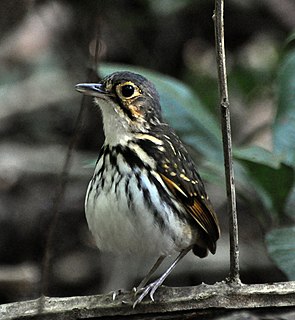 W
WThe streak-chested antpitta or spectacled antpitta is a species of bird in the family Grallariidae. It is found in Colombia, Costa Rica, Ecuador, Honduras, Nicaragua, and Panama. Its natural habitat is subtropical or tropical moist lowland forest.
 W
WThe Alta Floresta antpitta is a species of antpitta of the family Grallariidae discovered in 2012.
 W
WThe Amazonian antpitta is a species of bird in the family Grallariidae. It is found in Bolivia, Brazil, and Peru. Its natural habitats are subtropical or tropical moist lowland forest and heavily degraded former forest.
 W
WThe bay antpitta is a species of bird in the family Grallariidae. It is endemic to Peru.
 W
WThe bicolored antpitta is a species of bird in the family Grallariidae. In 2020, genetic evidence revealed that the bicolored pitta is a member of the rufous antpitta species complex. It is found in Colombia and Ecuador. Its natural habitat is subtropical or tropical moist montane forest. It is threatened by habitat loss.
 W
WThe brown-banded antpitta is a species of bird in the family Grallariidae. It is endemic to Colombia.
 W
WThe chestnut antpitta is a species of bird in the family Grallariidae. It is endemic to Peru. In 2020, two new species previously believed to be populations of chestnut pitta were described: the Oxapampa antpitta and the Ayacucho antpitta; this has left the chestnut antpitta with a much reduced range.
 W
WThe chestnut-crowned antpitta is a species of bird in the family Grallariidae. It is found in Colombia, Ecuador, Peru, and Venezuela. Its natural habitats are subtropical or tropical moist montane forest and heavily degraded former forest, which it has a much greater tolerance for than most antpittas. Usually this bird lives at elevations of 1,900 to 3,100 meters (6,200–10,200 ft).
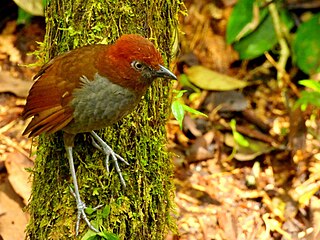 W
WThe chestnut-naped antpitta is a species of bird placed in the family Grallariidae.
 W
WThe crescent-faced antpitta is a species of bird in the family Grallariidae. It is found in Colombia and Ecuador.
 W
WThe Cundinamarca antpitta is a species of bird in the family Grallariidae. It is endemic to Colombia.
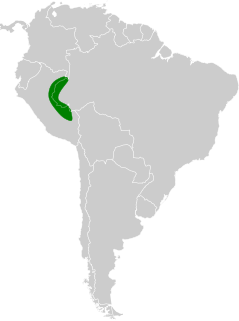 W
WThe elusive antpitta is a species of bird in the family Grallariidae. It is found in Brazil and Peru.
 W
WThe great antpitta is a species of bird in the family Grallariidae. It is endemic to Venezuela. Its natural habitat is subtropical or tropical moist montane forest. It is threatened by habitat loss.
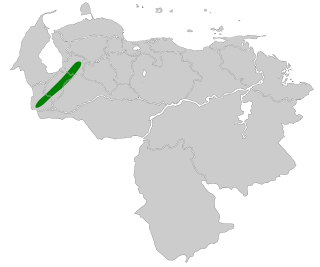 W
WThe grey-naped antpitta is a species of bird in the family Grallariidae. It is endemic to Venezuela.
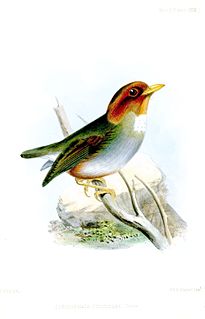 W
WThe hooded antpitta is a species of bird in the family Grallariidae. It is found in Colombia and Venezuela.
 W
WThe masked antpitta is a species of bird in the family Grallariidae. It is endemic to Bolivia in the city of Riberalta and around. It is in particular located in Puerto Hamburgo and in the Aquicuana Reserve.
 W
WThe moustached antpitta is a species of bird placed in the family Grallariidae.
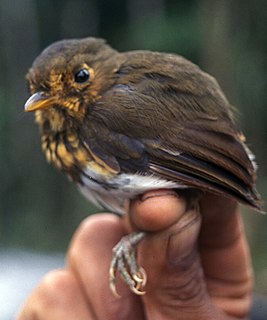 W
WThe ochre-breasted antpitta is a species of bird placed in the family Grallariidae.
 W
WThe ochre-fronted antpitta is a species of bird in the family Grallariidae. It is endemic to Peru.
 W
WThe ochre-striped antpitta is a species of bird in the family Grallariidae. It is found in Ecuador, Peru and southern Colombia.
 W
WThe pale-billed antpitta is a species of bird in the family Grallariidae. It is endemic to highland forest in the Andes of northern Peru.
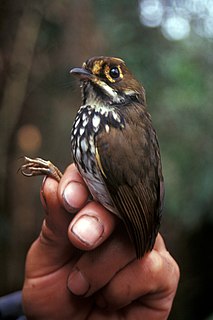 W
WThe Peruvian antpitta is a species of bird in the family Grallariidae. It is found in Ecuador and northern Peru.
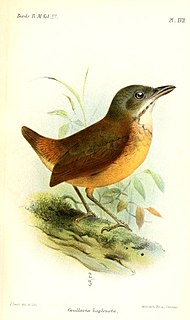 W
WThe plain-backed antpitta is a species of bird in the family Grallariidae. It is found in the Andes of Ecuador and the Venezuelan Coastal Range. Its natural habitats are subtropical or tropical moist montane forest and heavily degraded former forest.
 W
WThe red-and-white antpitta is a species of bird in the family Grallariidae. It is endemic to Peru.
 W
WThe rufous antpitta was a species of bird in the family Grallaridae that, in 2020, was found to be a species complex made up of 13 visually similar, but distinct species.
 W
WThe rufous-breasted antpitta or leymebamba antpitta is a species of bird in the family Grallariidae. It was first described by American ornithologist and entomologist Melbourne Armstrong Carriker. It is found in Peru and western Bolivia. Its natural habitats are subtropical or tropical moist montane forest and heavily degraded former forest. It has been recently considered a subspecies of Grallaricula ferrugineipectus.
 W
WThe rufous-faced antpitta is a species of bird in the family Grallariidae. It is endemic to Bolivia.
 W
WThe rusty-breasted antpitta is a species of bird in the family Grallariidae. It is found in the Andes of Colombia and Venezuela. Its natural habitats are subtropical or tropical moist montane forest and heavily degraded former forest.
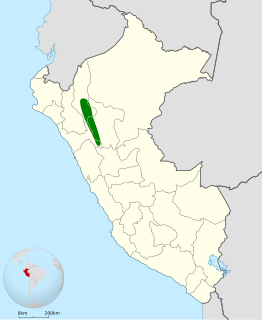 W
WThe rusty-tinged antpitta is a species of bird in the family Grallariidae. It is endemic to Peru.
 W
WThe Santa Marta antpitta is a species of bird in the family Grallariidae. It is endemic to Colombia. Its natural habitat is subtropical or tropical moist montane forest. It is threatened by habitat loss.
 W
WThe scaled antpitta is a species of bird in the family Grallariidae.
 W
WThe scallop-breasted antpitta is a species of bird in the family Grallariidae. It is endemic to the Venezuelan Coastal Range.
 W
WThe slaty-crowned antpitta is a species of bird placed in the family Grallariidae.
 W
WSnethlage's antpitta is a species of antpitta in the family Grallariidae. It was formerly considered conspecific with the spotted antpitta.
 W
WThe speckle-breasted antpitta is a species of bird in the family Grallariidae. It is found in Argentina, Brazil, and Paraguay. It is monotypic in the genus Cryptopezus. Its natural habitats are subtropical or tropical moist lowland forest and subtropical or tropical moist montane forest.
 W
WThe spotted antpitta is a species of bird in the family Grallariidae. It is found in Bolivia, Brazil, Colombia, Ecuador, French Guiana, Guyana, Peru, Suriname, and Venezuela. Its natural habitat is subtropical or tropical moist lowland forest.
 W
WThe stripe-headed antpitta is a species of bird in the family Grallariidae. It was first described by German ornithologist Jean Louis Cabanis. It is found in Peru and western Bolivia. Its natural habitat is subtropical or tropical moist montane forest.
 W
WThe Sucre antpitta is a species of bird placed in the family Grallariidae.
 W
WThe Tapajos antpitta is a species of bird in the family Grallariidae.
 W
WThe tawny antpitta is a species of bird in the family Grallariidae.
 W
WThe tepui antpitta or brown-breasted antpitta is a species of bird in the family Grallariidae.
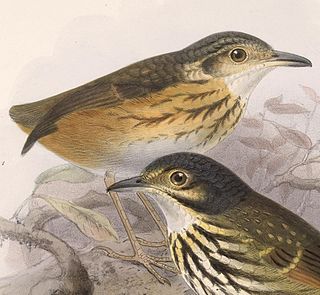 W
WThe thicket antpitta is a species of bird in the family Grallariidae. It is found in Colombia, Costa Rica, Honduras, Nicaragua, Panama, and perhaps Ecuador. Its natural habitats are subtropical or tropical moist lowland forest and heavily degraded former forest.
 W
WThe thrush-like antpitta is a species of bird in the family Grallariidae.
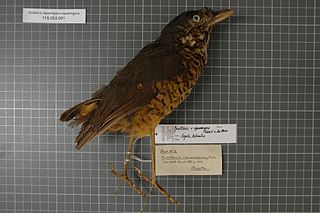 W
WThe undulated antpitta is a bird in the family Grallariidae. The species was first described by Florent Prévost and Marc Athanase Parfait Œillet des Murs in 1842.
 W
WWatkins's antpitta or scrub antpitta, is a species of bird in the family Grallariidae. It is found in Ecuador and Peru.
 W
WThe white-bellied antpitta is a species of bird in the family Grallariidae. It is found in Colombia, Ecuador and far northern Peru.
 W
WThe white-browed antpitta is a species of bird in the family Grallariidae. It is endemic to Brazil.
 W
WThe white-lored antpitta or fulvous-bellied antpitta is a species of bird in the family Grallariidae. It is found in Colombia, Ecuador, and Peru. Its natural habitats are subtropical or tropical moist lowland forest and heavily degraded former forest.
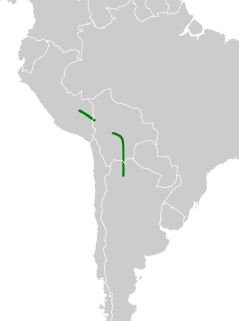 W
WThe white-throated antpitta is a species of bird in the family Grallariidae. It is found in Argentina, Bolivia, and Peru.
 W
WThe yellow-breasted antpitta is a species of bird in the family Grallariidae.
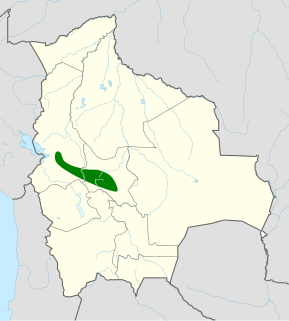 W
WThe Bolivian antpitta is a bird in the family Grallariidae. The species was first described by James Bond and Rodolphe Meyer de Schauensee in 1940. It is endemic to Bolivia. It is a member of the rufous antpitta species complex and was elevated from subspecies to species in 2020 on the basis of differences in plumage and vocalizations.
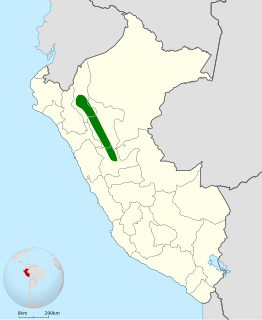 W
WThe Chachapoya antpitta is a species of bird in the family Grallariidae. It is endemic to Peru. It is a member of the rufous antpitta species complex and was first described by Morton L. Isler, R. Terry Chesser, Mark B. Robbins and Peter A. Hosner in 2020.
 W
WGrallaria is a large genus of Neotropical birds in the antpitta family Grallariidae.
 W
WGrallaricula is a genus of bird in the family Grallariidae.
 W
WHylopezus is a genus of bird in the family Grallariidae.
 W
WThe Junín antpitta is a species of bird in the family Grallariidae. It is endemic to the Peruvian department, Junín. It is a member of the rufous antpitta species complex and was formally elevated from subspecies to species in 2020.
 W
WMyrmothera is a genus of birds belonging to the family Grallariidae. Established by French ornithologist Louis Jean Pierre Vieillot in 1816, it contains two or three species, depending on the taxonomy followed. The International Ornithological Congress (IOC) recognises three species:Thrush-like antpitta Tapajos antpitta Tepui antpitta
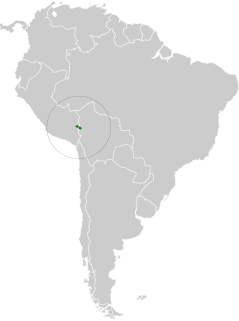 W
WThe Puno antpitta is a species of bird in the family Grallariidae. It is a member of the rufous antpitta species complex and was first described by Mark B. Robbins, Morton L. Isler, R. Terry Chesser and Joseph Tobias in 2020. It is found in the Peruvian department of Puno and the Bolivian department of La Paz.